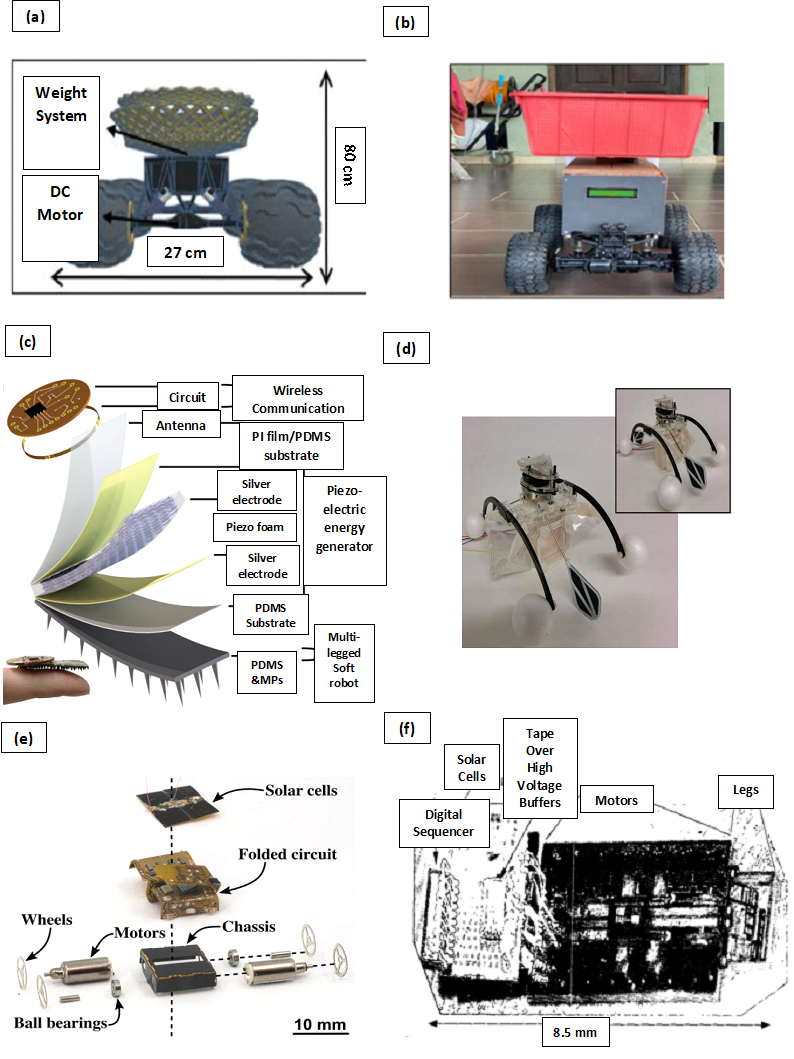Self-Powered Robots – A Survey
Keywords:
Autonomous robots, Self-Powered Robots, Robotics, Energy Harvesting, Structural Health Monitoring, Pipeline InspectionAbstract
Self-powered robots represent a significant advancement in autonomous robotics, leveraging renewable energy sources such as solar panels, thermoelectric generators, piezoelectric actuators, microbial fuel cells, and RF energy harvesting to operate independently of traditional power supplies. This study presents a comparative analysis of seven self-powered robotic systems, including the Crabbot, Thermoelectric Quadruped, MilliMobile, and Row-bot, evaluating their energy mechanisms, power consumption, control systems, and application domains. Notable findings include the Crabbot's 85 nm resolution and 150 V piezoelectric actuation for precision tasks, the Thermoelectric Quadruped's 703 J/m gait energy cost for geothermal monitoring, and MilliMobile's submillimeter-scale battery-free operation via RF harvesting. These robots are assessed based on critical parameters such as load-to-weight ratio, energy autonomy, and control architecture. The study highlights the growing role of miniaturized, energy-efficient designs in enabling real-world deployment across sectors like pipeline inspection, remote environmental sensing, and disaster response. By identifying performance benchmarks and gaps, this paper offers insight into next-generation, self-sufficient robotics aimed at sustainability, reliability, and broader societal impact.
References
F. K. Atif Sardar Khan, “A Wearable Solar Energy Harvesting Based Jacket With Maximum Power Point Tracking for Vital Health Monitoring Systems,” IEEE Access, vol. 99, pp. 1–1, 2022, doi: 10.1109/ACCESS.2022.3220900.
F. U. K. Atif Sardar Khan, “A survey of wearable energy harvesting systems,” Int. J. Energy Res., vol. 46, no. 3, p. 3, 2022, doi: https://doi.org/10.1002/er.7394.
F. U. K. Atif Sardar Khan, “Experimentation of a Wearable Self-Powered Jacket Harvesting Body Heat for Wearable Device Applications,” J. Sensors, 2021, [Online]. Available: https://onlinelibrary.wiley.com/doi/10.1155/2021/9976089
C. Z. Xiong Pu, “Triboelectric nanogenerators as wearable power sources and self-powered sensors,” Natl. Sci. Rev., vol. 10, no. 1, p. 1, 2022, [Online]. Available: https://pmc.ncbi.nlm.nih.gov/articles/PMC9843157/
M. Wajda, S., Leś, Z., & Szczepanik, “Development of the solar energy harvesting for powering a crawling robot,” IEEE Access, vol. 9, pp. 139248–139257, 2021.
L. Lu, Y., Gao, L., & Li, “An autonomous robot for precision weed control in maize,” Comput. Electron. Agric., vol. 177, p. 105713, 2020.
F. U. K. Wahad Ur Rahman, Atif Sardar, “ANALYTICAL AND FEA OF PIEZOELECTRIC VIBRATION ENERGY HARVESTERS FOR IOT-BASED RAILWAY TRACK MONITORING SYSTEM,” J. LIAONING Tech. Univ. (NATURAL Sci. Ed., 2024, [Online]. Available: https://lgjdxcn.asia/public_article.php?article=272
Z. L. Wang, “Triboelectric nanogenerators as new energy technology for self-powered systems and as active mechanical and chemical sensors,” ACS Nano, vol. 7, no. 11, pp. 9533–9557, Nov. 2013, doi: 10.1021/NN404614Z/ASSET/IMAGES/MEDIUM/NN-2013-04614Z_0020.GIF.
S. Lineykin and S. Ben-Yaakov, “Modeling and analysis of thermoelectric modules,” IEEE Trans. Ind. Appl., vol. 43, no. 2, pp. 505–512, Mar. 2007, doi: 10.1109/TIA.2006.889813.
F. U. K. Atif Sardar Khan, “A Photovoltaic System Maximum Power Point Tracking Techniques Comparison under Variable Atmospheric Condition,” IEEE Access, vol. 10, 2022, [Online]. Available: https://zkdx.ch/journal/zkdx/article/view/110
A. Chauhan and P. Avti, “Implantable Biofuel Cells for Biomedical Applications,” Biofuel Cells Mater. Challenges, pp. 69–95, Jan. 2023, doi: 10.1002/9781119725008.CH3.
W. Niu, H., Zhang, X., Su, Y., & Liu, “A hybrid energy harvesting system for autonomous power supply in wearable electronics,” Energy Convers. Manag., vol. 243, 2021.
Y. Li, L., Ren, L., & Tian, “Design and simulation of solar powered rover for extraterrestrial exploration,” 2019 IEEE Int. Conf. Mechatronics Autom., pp. 1476–1481, 2019.
L. Jian, S., Ren, L., & Li, “A review of swarm robotics: Advances in localization, task allocation, and communication,” Int. J. Adv. Robot. Syst., vol. 17, no. 2, 2020.
S. M. Muhammad Akmal Musa, “Solar Powered Autonomous RC Robot,” Prog. Eng. Appl. Technol., vol. 4, no. 2, pp. 133–144, 2023, [Online]. Available: https://publisher.uthm.edu.my/periodicals/index.php/peat/article/view/13136
Y. S. Haojian Lu, Ying Hong, Yuanyuan Yang, Zhengbao Yang, “Battery-Less Soft Millirobot That Can Move, Sense, and Communicate Remotely by Coupling the Magnetic and Piezoelectric Effects,” Adv. Sci., 2020, doi: https://doi.org/10.1002/advs.202000069.
H. Philamore, J. Rossiter, A. Stinchcombe, and I. Ieropoulos, “Row-bot: An energetically autonomous artificial water boatman,” IEEE Int. Conf. Intell. Robot. Syst., vol. 2015-December, pp. 3888–3893, Dec. 2015, doi: 10.1109/IROS.2015.7353924.
Z. E. Kyle Johnson, “MilliMobile: An Autonomous Battery-free Wireless Microrobot,” Proc. Annu. Int. Conf. Mob. Comput. Netw., pp. 1–16, 2023, [Online]. Available: https://dl.acm.org/doi/10.1145/3570361.3613304
S. Hollar, A. Flynn, C. Bellew, and K. S. J. Pister, “Solar powered 10 mg silicon robot,” Proc. IEEE Micro Electro Mech. Syst., pp. 706–711, 2003, doi: 10.1109/MEMSYS.2003.1189847.
M. Xuefeng, Y. Liu, L. Junkao, and D. Jie, “Crabbot: A Pole-Climbing Robot Driven by Piezoelectric Stack,” IEEE Trans. Robot., vol. 38, no. 2, pp. 765–778, Apr. 2022, doi: 10.1109/TRO.2021.3102418.
N. Dell, R., Unnthorsson, R., Wei, C. S., & Mitchell, “A thermoelectric powered quadruped robotic system for remote monitoring of geothermal open field heated gardens in Iceland,” GRC Trans., vol. 40, 2016.

Downloads
Published
How to Cite
Issue
Section
License
Copyright (c) 2025 50sea

This work is licensed under a Creative Commons Attribution 4.0 International License.




















